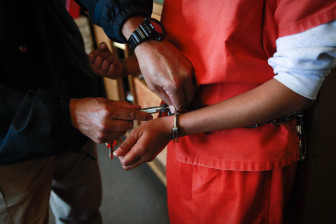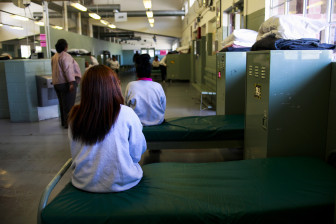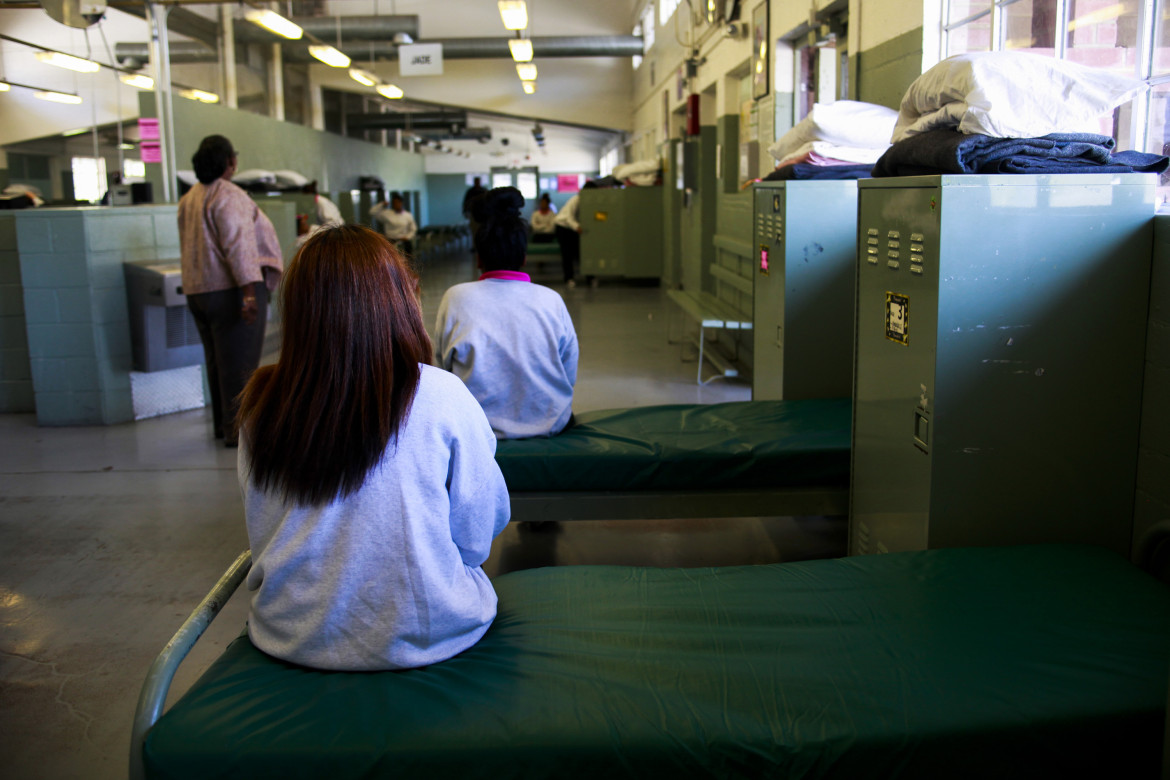
Bethany Mollenkof / Los Angeles Times/MCT
A new arrival at Camp Kenyon Scudder has her handcuffs removed after arriving at the girls' detention center, February 27, 2013, in Santa Clarita, California. The camp is implementing a new health screening program that is trying to address the problems females might face coming into LA County's juvenile justice system and flag girls who might need any additional help.
In 2010, the federal Office of Juvenile Justice Delinquency Prevention released results from the first-ever nationally representative survey of youth confined in juvenile justice facilities. This Survey of Youth in Residential Placement (SYRP) offered a treasure trove of information about the mental health and substance abuse problems faced by confined youth and the treatment provided to them. See related story here.
However, because interviews were conducted back in 2003, the SYRP findings beg the question: What changes have occurred since 2003 in mental health care for confined youth?
Unfortunately, few national data on the breadth or quality of mental health treatment in juvenile facilities have become available since 2003. Yet there is no doubt that awareness of mental health needs among delinquent youth has grown substantially, and there are many signs that services have improved.
Carefully constructed mental health screening and assessment tools, once rare, are now used routinely in juvenile detention and correctional facilities nationwide. And either voluntarily or in response to conditions of confinement lawsuits, many states have hired additional mental health professionals and substantially expanded counseling and treatment inside their juvenile facilities.
“I think that [state facilities] are better equipped to work with the mental health population today,” says Ned Loughran, executive director of the Council of Juvenile Correctional Administrators, a membership organization for state youth corrections agency heads. “States are using the results of the screening and assessments to build treatment plans,” Loughran says. “Is it perfect? No, it’s not perfect. But it’s far better than it was 10 or 15 years ago.”
However, experts caution that serious gaps remain in treatment for youth in confinement. Front-line workers in many facilities are not trained to understand or respond appropriately to young people with mental health problems, they say. And widespread reports of violence and maltreatment in juvenile facilities suggest that many confined youth continue to be housed in unhealthy environments that are likely to exacerbate their underlying mental health conditions.
Recognition of the Mental Health Challenge in Juvenile Justice
Twenty years ago, a national study on mental health in our nation’s juvenile justice systems yielded an alarming conclusion: “For the most part, current mechanisms and instruments for systematically screening and evaluating these youth are nonexistent and current treatment approaches are ineffective.”
“We still know very little about the mental health needs of youth who are involved in the juvenile justice system,” found the 1992 study, published by the National Coalition for the Mentally Ill in the Criminal Justice System. In addition, the study said, “The services now typically available in the juvenile justice system -- when any services are provided -- bear little resemblance to what either common sense or empirical research suggests is likely to be effective.”
In the late 1990s, however, the mental health needs of young people in the delinquency system began to garner more attention. When the Council of Juvenile Correctional Administrators (CJCA) first surveyed state youth corrections agencies about their mental health treatment efforts in 2004, 34 of the 40 states answering the survey had already adopted standardized screening procedures for youth admitted to correctional facilities. Most of these states (23 of 34) employed the Massachusetts Youth Screening Instrument (or MAYSI) – a 15-minute, 53-item questionnaire that can be conducted by front-line staff without counseling credentials to identify young people with signs of mental illness.

Bethany Mollenkof / Los Angeles Times/MCT
Girls detained at Camp Kenyon Scudder sit in heir shared dorm space at the Santa Clarita detention facility, February 27, 2013. The camp is implementing a new health-screening program that trying to address the problems females might face coming into LA County's juvenile justice system and flag girls who might need any additional help.
However, few states were following best practice in 2004 when it came to in-depth assessments for youth who did demonstrate mental health symptoms. As the 2004 CJCA report stated, “a normed, age-appropriate and validated mental health assessment should be completed by a trained and qualified mental health professional” for all youth with elevated risks for mental illness. Yet most states were assessing youth informally, CJCA found, concluding that, “mental health assessments in juvenile facilities are variable and not usually based on scientifically-sound instruments.”
When CJCA asked states in 2004 what share of youth confined in their facilities was assessed as mentally ill, only 11 states provided data. Thirty-two states were unable to answer.
More and Better Mental Health Screening
CJCA’s most recent survey of mental health treatment in state youth corrections agencies, conducted in 2010, revealed significant progress. By then 43 of 45 states screened all youth for mental illness, with 38 states using the MAYSI screening tool. States also reported using a wide array of validated assessment tools, often in combination -- a significant improvement over 2004. In addition, 22 states in 2010 were able to provide data on the number of youth with mental health problems -- twice as many as in 2004.
“I think there’s an incredibly greater awareness of the fact that many of these youth have mental health issues,” says Joseph Cocozza, director of the National Center for Mental Health and Juvenile Justice (NCMHJJ).
Less clear, however, is whether the increased awareness resulting from improved screening and assessment is resulting in better care for emotionally disturbed youth in custody.
“What we’re worried about now is what do you do about it when you can identify it,” says Thomas Grisso, the University of Massachusetts Medical School professor who developed the MAYSI screening instrument. “How can we get resources to respond to those kids that we can identify as having needs? Ironically, now that we are identifying kids, we’re recognizing the size of the problem.”
On the positive side, there are many indications that mental health treatment provided in juvenile facilities has become both more prevalent and more sophisticated.
CJCA’s most recent survey found that state youth corrections agencies employed more than 2,200 mental health professionals in 2010. While CJCA does not have hard data on mental health staffing or programming trends from previous years, Loughran says that most states have increased their mental health capacity, either by hiring staff, partnering with outside agencies, or both.
Virtually all state corrections agencies now offer cognitive behavioral therapy, which uses role playing and other strategies to help confined youth stay out of trouble. Studies find that this type of therapy – which teaches strategies to improve self-control, defuse tense situations and empathize with others’ feelings – reduces reoffending rates by 25 percent for juvenile and adult offenders alike.
Despite the expanded efforts in mental health assessment and treatment, however, reports of recurring youth-on-youth violence, routine use of solitary confinement, and excessive use of force by facility staff all remain widespread in youth corrections facilities nationwide. In 2011, an Annie E. Casey Foundation report found that 17 states have been successfully sued over conditions of confinement since 2000, and credible reports of maltreatment had emerged from public watchdog agencies or the media in five others states. Since 2011, maltreatment in correctional facilities has been documented in three additional states.
Indeed, in many states, increases in mental health programming have resulted directly from conditions of confinement lawsuits – many of which have ended with consent decrees requiring states to take remedial action. Unfortunately, in several of these states -- including Ohio, New York, and Texas, among others -- recent reports have found continuing widespread violence or maltreatment inside state youth facilities.
A Need for Training
“Most of the staff in most juvenile justice facilities do not have any background or training in mental health or behavioral health issues,” says Cocozza. “The juvenile justice system was not built to be psychiatric centers, but what’s happened over time is that many of these youth are ending up in the juvenile justice system.”
“Some of the things that go on are, honestly, just a lack of understanding among staff,” Cocozza adds. You know, the kid is doing these things and I think he’s being a pain in the ass confronting me, when in fact it’s just a symptom of the kinds of problems the kid is having in terms of mental health.”
In recent years, Cocozza’s organization has been working to improve training on adolescent mental health for non-clinical staff in juvenile facilities. With funding from the John D. and Catherine T. MacArthur Foundation, NCMHJJ developed a train-the-trainer curriculum and delivered it to staff in the eight states participating in the Models for Change project’s Mental Health Juvenile Justice Action Network.
Last year, with additional funding from the federal Office of Juvenile Justice and Delinquency Prevention, NCMHJJ issued a request for proposals to see if other states might want to participate in this training.
The response was overwhelming, Cocozza says, with 46 agencies in 35 different states submitting proposals. After a competitive selection process, the curriculum has now been delivered in 9 of the 10 states selected. In each, NCMHJJ has trained 40 staff, and the participating states have pledged to deliver the training themselves to workers in at least three detention or corrections facilities.
“The staff needs to understand what it is that they’re seeing,” Cocozza says, “and how to respond in an appropriate way that both helps the kid and keeps them safe.”
Fewer kids in state custody, more community-based treatment
Cocozza and Loughran both argue that the behavior management challenge in youth facilities has grown more difficult in recent years as youth with less serious offending histories have been increasingly steered away from secure juvenile detention and corrections facilities. As the Annie E. Casey Foundation documented in a recent data brief, the overall youth confinement rate fell 37 percent nationwide from 1997 to 2010.
“Because the low-risk youths are being diverted from the deep end of the system, and a number of facilities have closed, there’s a concentration of older, more aggressive kids, and a group of kids with serious mental health problems,” Loughran says, “so a number of programs around the country are experiencing a rise in violent behavior."
“There needs to be improved services, better training, better access to effective services. I think … the screening is getting in place in many instances,” Cocozza adds. “So that’s the place where we’re trying to have an impact.”
This series is part of an ongoing collaborative with the Center for Public Integrity.
